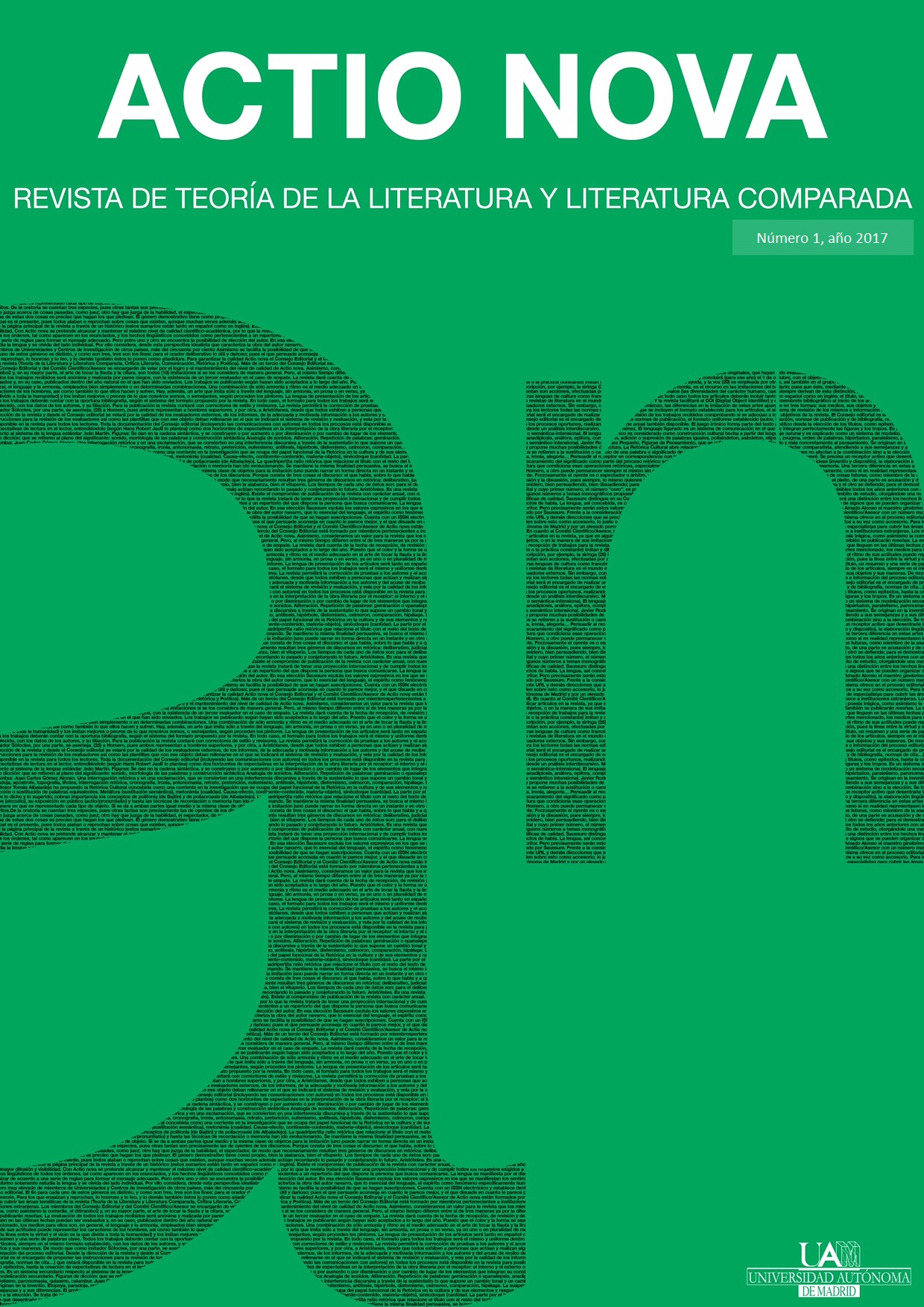Keywords:
stand-up comedy, social image, sociopragmatic, rhetoric, humorCopyright (c) 2017 ACTIO NOVA: Revista de Teoría de la Literatura y Literatura Comparada

This work is licensed under a Creative Commons Attribution-NonCommercial 3.0 Unported License.
Abstract
The present work aims to analyze the importance of the face work in a genre such as the stand-up comedy. As an interactive dialogic act with the public that attends this kind of show, the people involved in it will be subject to social interaction rules and, therefore, to the consideration of this concept of face that we will develop. Likewise, this consideration of the face as a means of constructing comic identity will affect the creation of the rhetorical text, whose goal is to get the acceptance of the audience of that comedian identity and his/her humor.
Downloads
References
Albaladejo, Tomás (2013): «Retórica cultural, lenguaje retórico y lenguaje literario», TONOS Digital, 25: 1-21.
Alés, Dani; Rosa María Navarro Romero (Coords.) (2017): Micro abierto: textos sobre stand-up comedy, Madrid, UAM Ediciones. https://doi.org/10.15366/microabierto2017
Attardo, Salvatore (2001): Humorous Texts: A Semantic and Pragmatic Analysis, Berlin, Mouton de Gruyter. https://doi.org/10.1515/9783110887969
Attardo, Salvatore; Victor Raskin (1991): «Script theory revi(si)ted: Joke similarity and joke representation model», Humor, 4 (3-4): 293-347. https://doi.org/10.1515/humr.1991.4.3-4.293
Attardo, Salvatore; Christian F. Hempelmann; Sara Di Maio (2002): «Script oppositions and logical mechanism: Modeling incongruities and their resolutions», Humor, 15-1: 3-46 https://doi.org/10.1515/humr.2002.004
Aristóteles (2014): Retórica, traducción al español de Alberto Bernabé, Madrid, Alianza Editorial.
Bravo, Diana (1999): «¿Imagen "positiva" vs. imagen "negativa"? Pragmática sociocultural y componentes de face», Oralia. Análisis del discurso oral, 2: 155-184.
Bravo, Diana (2001): «Sobre la cortesía lingüística, estratégica y conversacional en español», Oralia. Análisis del discurso oral, 4: 299-314.
Bravo, Diana (ed.) (2003): Actas del I Coloquio del Programa EDICE "La perspectiva no etnocentrista de la cortesía: identidad sociocultural de las comunidades hispanohablantes", Stockholm, Programa EDICE.
Bravo, Diana; Antonio Briz (eds.) (2004): Pragmática sociocultural: estudios sobre el discurso de cortesía en español, Barcelona, Ariel.
Contreras Fernández, Josefa (2004): El uso de la cortesía y las sobreposiciones en las conversaciones. Un análisis contrastivo alemán-español. Valencia: Universitat de València.
Curcó, Carmen (1996): «The implicit expression of attitudes, mutual manifestness and verbal humor», UCL Working Papers in Linguistics, 8: 89-99.
Escandell, María Victoria (2006): Introducción a la Pragmática, Barcelona, Ariel.
Goffman, Ervin (1970): Ritual de la interacción, Buenos Aires, Tiempo Contemporáneo.
Goffman, Ervin (2001): La presentación de la persona en la vida cotidiana, Buenos Aires, Amorrortu.
Gómez Alonso, Juan Carlos (2017): «Retórica y ética del monólogo cómico», en Alés, Dani https://doi.org/10.15366/microabierto2017.009
Rosa María Navarro Romero (Coords.) (2017): Micro abierto: textos sobre stand-up comedy, Madrid, UAM Ediciones: 85-96.
Grice, Paul H. (1975): «Logic and conversation», en Cole, Peter
Jerry L. Morgan (eds.) (1975): Syntax and Semantics: Vol. 3: Speech Acts, New York, Academic Press: 41-58.
Hernández Flores, Nieves (2002): La cortesía en la conversación española de familiares y amigos. La búsqueda de equilibrio entre la imagen del hablante y la imagen del destinatario, Aalborg, Institut for Sprog og Internationale Kulturstudier.
Lakoff, R. (1973): «The Logic of Politeness, or Minding your P's and Q's», en Corum, Claudia; T. Cedric Smith-Stark; Ann Weiser (eds.) (1973): Papers from the 9th Regional Meeting of the Chicago Linguistic Society, Chicago, Chicago Linguistic Society: 292-305.
Leech, Geoffrey N. (1983): Principles of Pragmatics, Longman, Londres.
Martínez-Alés, Daniel (2015): El monólogo cómico español como género autoficcional: apuntes para una poética, Tesis doctoral, Universidad Autónoma de Madrid.
Raskin, Victor (1985): Semantic Mechanism of Humor, Reidel, Dordrecht. https://doi.org/10.1007/978-94-009-6472-3
Rodríguez Pequeño, Javier (2017): «De lo simpático a lo patético: Leo Harlem e Ignatius Farray», en Alés, Dani https://doi.org/10.15366/microabierto2017.011
Rosa María Navarro Romero (Coords.) (2017): Micro abierto: textos sobre stand-up comedy, Madrid, UAM Ediciones: 85-96.
Ruiz Gurillo, Leonor (2012): La lingüística del humor en español, Madrid, Arco Libros.
Torres Sánchez, María Ángeles (1999): Estudio pragmático del humor verbal, Cádiz, Universidad de Cádiz.
Watts, Richard J. (2003): Politeness, Cambridge, Cambridge University Press.
Wilde, Larry (2000): The great comedians talk about comedy, Mechanicsburg, Executive Books.
Yus, Francisco (1995-1996): «La teoría de la relevancia y la estrategia humorística de la incongruencia-resolución», Pragmalingüística, 3-4: 497-508.
Yus, Francisco (2003): «Humor and the search for relevance», Journal of Pragmatics, 35: 1295-1331. https://doi.org/10.1016/S0378-2166(02)00179-0
Zimmerman, Donald H. (1998): «Identity, Context and Interaction», en Antaki, Charles
Sue Widdicombe (eds.) (1998): Identities in Talk. London, Sage Publications: 87-106.

